#Inscriptiones
Text
tagged by @jonathanssweatercollection (thank you!!)
lockscreen:

i can't get the clock to not be over her face unfortunately but yeah i got a compliment on it the other day <3 the album came out today but i haven't had time to listen to it yet :(
last song listened to:
joni my beloved <3 also i'm an apple music user so rip to spotify users who can't listen to joni i would literally not be able to live without her
last picture:

it's a picture of a page in a library book that i have to return but still need for my dissertation!! veeeery exciting :) enjoy this excerpt of samuel quiccheberg's seminal 1565 work inscriptiones vel tituli theatri amplissimi <3
tagging @frankensteintrans @roombagreyjoy @frasiercraneshumongousasscontest @hardoncaulfield if they want to!
5 notes
·
View notes
Text
Baloane Personalizate Nunta - Aici gasiti toate modelele
Baloane Personalizate Nunta
Baloane Personalizate Nunta
Se pot comanda minim 30 baloane personalizate cu un singur model/matrita/fotografie/logo.
Pretul afisat include balonul si personalizarea, respectiv prelucrarea fotografiei si pregatirea pentru inscriptionarea balonului.
Baloanele pot fi inscriptionate doar intr-o singura culoare.
Baloanele se pot comanda multicolore (mai multe culori), o…

View On WordPress
0 notes
Text
A Better Way to Get Data
0: Been a Minute
I came out the gate real strong on these dev blogs then completely dropped off. Oops.
In my defense, I got an actual salaried job, and it has been pretty hectic. Like, miss-application-deadlines-for-PhD-programs hectic. It's not all bad though! For starters, I honestly need the break from being a student. Also, it's a ~tech job~ and I'm taking the opportunity to learn more about programming, tool development, and project management.
"Why does any of this matter?"
Because a current work project clued me into a better way to collect inscriptional data!
1: A Better Way
In previous posts, I explained how to scrape Greek inscriptions from the Packard Humanities Institute website. Here's that post (link), if you want some context.
This is the method I used for my thesis, but it has some problems. It's pretty slow (I had to leave the full scraper + cleaner to run overnight), and it wasn't the most accurate. Since the data was just sitting untagged in pretty minimal HTML format, nothing was really tagged. I worked around this by giving the scraper search parameters with some... functional Regular Expression (I'll cover that in head crushing detail later). Unfortunately, Regular Expression is an avatar of the devil and my sloppy search parameters introduced numerous errors, especially when it came to inscription dates.
However, we can do away with scraping entirely and retrieve the data in XML format, along with more details about the book and chapter of the Inscriptiones Graecae they're found in, using API calls!
2: What's an API?
idk. someone elses code for you to vandalize.
ok, API stands for application programming interface. An application is just a piece of software that fulfills a function, and an API communicates between applications.
So say you have a website that shows you some data. In this example by John Watson Rooney, it's listings of sunglasses from the Sunglass Hut website. Rather than hard-code a page with every pair of sunglesses and the corresponding prices, the website has a field for the different offerings that's filled in by an API. When you open a list of sunglasses, an API grabs the relevant data and presents it to the website for formatting. In this example, the website is one application, the data server (or partition, etc.) is another application, and the API is responsible for carrying information about sunglasses in between the two.
That means the data is actually stored separately from the website. If you wanted to, you could just call that API yourself and retrieve the raw data!
3: Applying This
Now here's where we can start to apply things. Multiple volumes of the Inscriptiones Graecae are available online, free of charge, through the Berlin-Brandenburgische Akademie der Wissenschaften (the current publishers). Here's a link, but note that it's not a secure page.
I originally bounced off this site and landed on the Packard Humanities institute because I only knew how to scrape, and the Akademie's APIs had me totally confounded. But I've leveled up, and I think it's time to use the resource to its fullest.
There are a few APIs at work here. One just gets a list of all the inscriptions, organized by book, in JSON format (don't...worry abt it just yet). Just slap this into your browser and take a look:
http://telota.bbaw.de/ig/api/inscriptions
Another
Another gets information about each volume, including the subject region, volume name, and (very crucially!) the volume identifier used by the APIs to select a specific book. Check this one out too:
http://telota.bbaw.de/ig/api/getVolumes
The site has plenty more: some for grabbing chapters, some for sections organized by chapter, some for an ordered list of sections without chapters, etc. Every which way you could want to get information about a book, you have it.
Then, at the very end of it all, you can grab an actual inscription, this time in XML format. Give this last one a try:
http://telota.bbaw.de/ig/api/xml/IG%20I%C2%B3%201
Let's take a second to parse that. It starts with "telota.bbaw.de": TELOTA stands for The Electronic Life Of The Academy, and BBAW stands for Berlin-Brandenburgische Akademie der Wissenschaften (Berlin-Brandenburg Academy of Sciences). TELOTA is the digital humanities wing of the BBAW!
Moving on, "ig" stands for Inscriptiones Graecae, and "api" denotes that we're making an API call, rather than viewing the site normally. Then, "xml" indicates the viewing format.
Now the good part! We have this arcane looking string "IG%20I%C2%B3%201". It's not actually all that bad — those %20s are just escape codes (remember we dealt with those before!) indicating spaces. Unescape them out and we get this
http://telota.bbaw.de/ig/api/xml/IG I%C2%B3 1
Well, doesn't that "IG I" look familiar!
That "%C2%B3" looks a little more complicated, but if we check this list of escape codes, we find that it's equivalent to ³ (superscript 3). Knowing that, we can unravel the rest of the link:
http://telota.bbaw.de/ig/api/xml/IG I³ 1
And there it is! The last portion is just the book series (IG), the volume (I³), and the inscription!
4: Putting It Together
So here's the plan. I need to write a script that uses the known APIs to call a list of each volume, its chapters, sections, etc. Using the data from the responses, it will gather a list of inscriptions by section into a table, where each row has the volume, chapter, section (etc), and inscription number. This will involve converting JSON to R tibbles, but I've experimented with the Jsonlite package which does just that. It's nothing too complicated!
Next, I need a script that will build API calls out of these inscription numbers, then use the responses to fill more data into the table. This will involve converting XML to R tibbles, which I don't have any experience with, but the data format is widely used so I expect tools have been developed.
Once that is done, I should have a table of inscriptions in (hopefully) much less time and with minimal errors in time or location data!
#quantitative linguistics#ancient greek#classics#classical greek#programming#API#historical linguistics#R#dialectology
0 notes
Text

"Bereits seit der Renaissance wurden Museen oftmals auch als „gespiegelte Theater“ bezeichnet. Eines der berühmtesten Beispiele ist das „Gedächtnistheater“ von Giulio Camillo im 16. Jahrhundert. Seine Inszenierungen dienten als Inspiration für das erste museumstheoretische Traktat der Geschichte (Samuel Quiccheberg: Inscriptiones vel Tituli Theatri Amplissimi, 1565). Am besten stellt man sich das „Gedächtnistheater“ als eine Art Amphitheater vor.
Auf dessen Rängen präsentierte Camillo viele unterschiedliche Bilder als universalen Wissensspeicher. Dadurch wird die Kommunikationsstruktur des Theaters gespiegelt: Im Mittelpunkt der Kunstrezeption stehen die Zuschauer*innen selbst auf der Bühne und wählen frei aus, welche Exponate sie betrachten möchten. Die Ausstellung wird als Spielraum betrachtet, in dem die Besucher*innen einen eigenen Weg durch die Ausstellungsdramaturgie verfolgen."
Sandra Knocke #museumpics, Fotografieren im Museum. GNM_Blog
0 notes
Text
SPIRITUS, CLASIS, SOCIETATIS INTERACTION
sexum et qui probabiliter putant se legales esse. Detur notae communitatis Bronx, vita anonyma, frequentia derelictionis, furti et interitus, experientiae praeteritae neglegentiae et indifferentiae, vandalismus ubi scit homines res privatas conservari et mores immoderatos carum esse.
videbunt, os clausum et alacres gressus eorum. Noli adtrectare. Quidam enim habitant, haec atomisatio crescens parum ponderis habebit, quia vicinia non est "domus eorum" sed ubi habitant. Eorum usus alibi, cosmopolitani sunt. Sed plurimum valet pro aliorum vita quae significationem et perfectionem a necessitudine sortiuntur ad realitatem localem quam ad reliquos mundum. Desinet enim eis vicinia esse, exceptis duobus fidelibus amicis, qui pendere procurabunt. Talis vicinitas sceleris incursione vulnerabilis est."
matertera multo ante in Theoria vitri fracti argumentatur quod vandalismus in Palo Alto staret, facilius occurrit in locis ubi signa negligentiae dominantur ut sensus humanitatis opprimat.
Sed vandalismus ubivis potest occurrere semel claustris collectivis — sensus mutuae observantiae et civilium officiorum — actus deprimuntur, qui tamquam neglectionis signa interpretari possunt.
Propositum nostrum est quod "neglectus" etiam ducit ad perniciem instrumentorum collectivorum imperii.
Plebs stabilis viciniae familiarum, quae domos suas tendunt, proximis liberis curant, et suspiciones invitorum extraneorum in formosam et inhospitalem silvestrem paucis annis vel etiam paucis mensibus vertere possunt. Res relicta est, terra zizania obsita, fenestra fracta. Adulti obiurgare protervitate pueri desinunt, et pueri etiam magis proterviam hortari sentiunt. Familiae alibi migrant et adulti soluti in viciniam se movent. Eleifend ante anguli copia. Mercator eos invitat ut se moveant. Negant. Pugnae erumpunt. Purgamentum strues populus bibens ante tabernam incipiunt. Tandem concidit ebrius in laeta, et ibi dormivit. Mendici adeunt transeuntes.
Gravis crimen vel violentia contra alienos non necessario vigent in vicinia hoc loco, sed multi incolas putabunt crimen, praesertim violentum crimen, in ortum esse et mores suos proinde accommodare. frequentiis per plateas exeant et, si opus sit, ad unam partem retineant;
Theoria vitri fracti pro sua simplicitate certe suggerit, sed stilla criminis in New York cum primis 1990s verisimiliter ob multiplices causas implicatas in complexu. Praeterea sceleris decrementum totum territorium Civitatum Americae Unitarum implicavit, etiamsi maximum pretium sociale consecutus est, cum multitudo carceris ab 600.000 hominibus in primis annis 1970 ad 2.2 milliones in 2007 abiit.
Ut plura de hisce rationibus disceret, discipulus legere potest articulum ab Alexandro Stille promptum in inscriptione interrete: http://download.repubblica.it/ pdf/domenica/2007/16092007.pdf.
Alia sententia potius nuntiatur a ephemeride "Ilfoglio" in articulo a Christian Rocca data 08/09/07 in promptu ad: http://www.ilfoglio.it/uploads/camillo/tollezerogiuliani.html
Alumni tunc investigationem suam dilatare potuerunt consulendo statistica quaedam circa problema criminis in Italia.
0 notes
Text
Why am I having such trouble accessing the Inscriptiones Graecae online? IG XII.6.2.540 where are you?
1 note
·
View note
Text
EVERY FOUNDER SHOULD KNOW ABOUT PROBLEMS
My test was to think of intelligence as inborn is that people trying to measure it have concentrated on the aspects of economic inequality where the cause of poverty is the same as the root cause of variation in income is a sign that something is broken? At Yahoo, user-facing software was controlled by product managers and designers the final step, by translating it into code. I'm not saying that if you let Henry Ford get rich, he'll hire you as a waiter at his next party. Somehow the idea of making really large amounts of money. When people come to you with a problem and you have to sound intellectual. All the hackers I know, managed to be mistaken. An organization that wins by exercising power starts to lose deals. That was not, probably, how McCarthy thought of it as a personal insult when someone from the other team from scoring is considered to have played a perfect game.1 Right now, VCs often knowingly invest too much money at the series A stage. And if you weren't rich, you took the omnibus or walked.
Microsoft.2 Great hackers also generally insist on using open source software. In that case, stay on a main branch becomes more than a way to please other people. It's so cheap to start, this conflict goes away, because founders can start them younger, when it's rational to take more risk, and can start more startups total in their careers. When you reach the point where 90% of a group's output is created by 1% of its members, you lose big if something whether Viking raids, or central planning drags their productivity down to the average Frankish nobleman in 800, and report back to us. Art History 101.3 Hacker News and our application system.4 That way we can avoid applying rules and standards to intelligence that are really meant for wisdom. Whereas the independence of the townsmen allowed them to keep whatever wealth they created.5 These initial versions can be so pervasive that it takes a great effort to overcome it. Then you could see in the house, the herds, and the number one thing they have in common. The difference is that wise means one has a high average outcome.
Editorialists ask. Bottom-up programming suggests another way to convince investors to let you do it? If circumstances had been different, the people running Yahoo might have realized sooner how important search was.6 But that won't eliminate great variations in wealth would mean eliminating startups.7 When I heard this, I thought he was a complete idiot.8 You can see wealth—in buildings and streets, in the original sense, is something you write to try to figure something out. The more of your application you can push down into a language for writing that type of application, the more we'll see multiple companies doing the same thing ourselves.9 Which is precisely why we hear ever more about it.10 Society as a whole ends up poorer. But startups aren't like that. In every case, the creation of wealth seems to appear and disappear like the noise of a fan as you switch on and off.11
Central France in 1100, off still feudal. Or consider watches. You have to be nice to, you have two options: work at home, hackers can arrange things themselves so they can get the most done. And they think of it as normal to have a remedial character. The idea is basically that you sort search results not in order of how much money Yahoo would make from each link. It consists of some things that are good and some that are historical trends with immense momentum and others that are random accidents.12 The place to look for what I learned from Paul Buchheit: it's better to make a deep point here about the true nature of wisdom, just to make sure they're ok guys. I don't think there's any limit to the number of failures and yet leave you net ahead.13 Thanks to Trevor Blackwell, Jessica Livingston, and Jackie McDonough for reading drafts of this.
One of the things pinned up on our bulletin board was an ad from IBM.14 Brandeis was a product of this period. But Apple created wealth, in the sense that the authors didn't know when they started exactly what they were trying to get people to start calling them portals instead of search engines. This isn't true in all fields. And this is the route to well-deserved obscurity. So it's not just fastidiousness that makes good hackers avoid nasty little problems is that you make what you measure.15 That's why Yahoo as a company has sunk into technical mediocrity and recovered.
And of course if Microsoft is your model, you shouldn't be looking for, most of the time, perhaps most of the time, and runtime. You'd seem a barbarian if you behaved that way today. Starting in the tenth and eleventh centuries, petty nobles and former serfs banded together in towns that gradually became powerful enough to appropriate it.16 If Lenin walked around the offices of a company like Yahoo or Intel or Cisco, he'd think communism had won.17 Why?18 It's hard to predict what will; often something that seems interesting at first will bore you after a month. Understanding your users is part of what makes them good hackers: when something's broken, they need to get a work visa in the US, without an undergraduate degree—but tests like this will matter less and less.19
Though useful to present-day languages, if they'd had them. When you look at the history of stone tools, technology was already accelerating in the Mesolithic. We think of the core language semantics.20 The design paradox means they're choosing more or less a subset of potential users, or satisfying a subset of the needs of a subset of the needs of a subset of potential users, or satisfying a subset of hash tables where the keys are vectors of integers. Whereas if you're doing the kind of productivity that's measured in lines of code. But between the two. He knows what happened in every deal in the Valley. Extraordinary devotion went into it, and most decent hackers are capable of that. As big a deal as the Industrial Revolution was well advanced.
Notes
Joshua Schachter tells me it was true that being part of wisdom. This is actually a computer. See, we can teach startups a lot like meaning.
We're only comparing YC startups, just that if colleges want to believe this much. If they're on the order of 10,000 sestertii for his freedom Dessau, Inscriptiones 7812. But you couldn't do the equivalent thing for founders, HR acquisitions are viewed by acquirers as more akin to hiring bonuses.
The point where things start to rise again. The most striking example I know of no Jews moving there, and that's much harder. I'm convinced there were about the origins of the things attributed to them.
If you ask parents why kids shouldn't swear, the police treat people more equitably. Please do not take the form of bad idea. In Boston the best day job, or at least should make what they do.
You have to do this right you'd have to deliver these sentences as if you'd invested at a pre-money valuation of the first phase of the most part and you can probably write a book about how things are different. The only people who get rich by creating wealth—university students, heirs, professors, politicians, and there are few who can say I need to fix once it's big, messy canvases that philistines see and say that's not art because it looks like stuff they've seen in the beginning. None at all. No, and there are no false negatives.
It tipped from being this boulder we had, we'd have understood why: If they were friendlier to developers than Apple is now very slow, but when people in return for something that conforms with their company made money from it, but they can't teach students how to value valuable things.
Everyone else was talking about art, they made, but investors can get done before that. There is a qualitative difference in investors' attitudes. I believe Lisp Machine Lisp was the least VC-like. So if you're attacked in this they're perfect.
By writing library functions. If you want as an example of computer security, and a little about how things are going well, but not in the early 90s when they buy some startups and not fundraising is a bridgehead. Oddly enough, even if they were to work than stay home with them in advance that you were expected to do good work and thereby earn the respect of their name, but that it's boring, we don't want to give them sufficient activation energy required to notice when it's their own interest.
On the other by adjusting the boundaries of what you really want, like warehouses. They can lead to distractions even more vice versa: the editor, which would be vulnerable both to attack the A P successfully defended itself by allowing the unionization of its identity. The real danger is that you'll have to resort to in order to pick the words we use the word wealth, seniority will become correspondingly more important.
It did not start to get going, and so don't deserve to keep their wings folded, as accurate to call those before a consortium of investors want to take action, go ahead. Gauss was supposedly asked this when comparing techniques for discouraging stupid comments instead.
I've learned about VC inattentiveness. The time it still seems to them unfair that things don't work the same thing. Actually he's no better or worse than close supervision by someone else. Mozilla is open-source but seems to have them soon.
107. The key to wasting time building it. IBM makes decent hardware. They seem to have a browser and get pushed down by new arrivals.
There will be interesting to 10,000 sestertii, for example. Some translators use calm instead of just Jews any more than others, and only one restaurant left on the East Coast VCs. There are circumstances where this is so new that it's no longer written in Lisp, they may introduce startups they like to fight.
We once put up with only a few percent from an eager investor, lest that set an impossibly high target when raising additional money. The US is the most successful founders is exaggerated now because it's a hip flask.
That's probably true of nationality and religion too. In practice it just feels like it if you have an edge over Silicon Valley, but a blockhead ever wrote except for money. You can get rich by creating wealth—that an eminent designer is any good at talking about why something isn't the last 150 years we're still only able to. It's true in fields that have it as a percentage of startups as they are in research departments.
I'm not saying it's impossible without a time before photography had a broader meaning.
This is a way to explain that the highest returns, like architecture and filmmaking, but we decided it would do for a startup could grow big in revenues without including the numbers from the success of their works are lost.
Many of these companies unless your last round of funding.
Garry Tan pointed out that taking time to come if they seem pointless. Considering yourself a scientist. If you want to sell, or to be very hard to do this are companies smart enough to guarantee good effects.
Probably just thirty, if you make something popular but from what the earnings turn out to be able to redistribute wealth successfully, because companies then were more dependent on banks for capital for expansion. The point of view anyway. Founders are often unknowns. Once again, that suits took over during a critical point in the sense of mission.
#automatically generated text#Markov chains#Paul Graham#Python#Patrick Mooney#guys#Lenin#point#VCs#Tan#time#company#Inscriptiones#outcome#thing#managers#sup#standards#Thanks#police#startups#way#developers#raids#Jackie#target#browser#feels#others#branch
1 note
·
View note
Text
as it turns out trawling through the IG is even worse than the CIL
#admittedly part of that is I don't know greek#but even so it seems way less accessible particularly online#and that's no mean feat considering how hard it can be to find some things in the CIL#(IG = inscriptiones graecae i.e. greek inscriptions#CIL = corpus inscriptionum latinarum i.e. latin inscriptions)
9 notes
·
View notes
Text
Poorly translated with Google; Κυπρο-Αργολικά
Ἀρταμίτιος was the month in honor of Artemis, common in many calendars, including neighboring Epidaurus (see Samuel 1972:91· Trump (1997: 141)
[…]
The name of the complete martyr so far in any calendar month Ἐριθαιέου is of particular interest. Etymologically it must probably be related to the word ὁ ἔριθος, which means “the worker, the day laborer”. In Homer in particular ἔριθοι are the reapers, while as a female, ἡ ἔριθος, means the weaver, probably from a paretymology that associated the word with ἔρια, hair. To the ancient lexicographers, ellexi generally means the workers of the earth.
[…] the fact remains that the original meaning of the word was “the laborer of the land” and later took on the meaning of “wage laborer” in general. .ριθος however, some cult adjectives Artemis and Apollo must also be associated. So, we have a mess of it from Attica 2 Ου A.D. century (Inscriptiones Graecae II 2, 5005) with the inscription Ἀρτέμιδος | Ἐρείθου
[…]
A third, more interesting testimony comes from Ptolemy Hepheastion, the so-called Hennon, writer from Alexandria, of about 100 AD. According to her, when Adonis died, Aphrodite wandered and looked for him, to finally find him in the city of Argos in Cyprus, in the sanctuary of Apollo Ἐριθίου : « O “(Excerpt 7 of the summary of the book of Ptolemy” Περὶ τῆς εἰς πολυμαθίαν καινῆς ἱστορίας λόγοι ΣΤ΄ “, Rescued by Photios, Library , 153α, 15 [Migne, Patrologia Graeca CIII, column 632]. Cf. Westermann 1843: 198, 11. Cf. also Pauly-Wissowa Realencyclopädie II, 1 (1895), column 52 s.v. Apollon (K. Wernicke) and VI, 1 (1907), p. 468, s.v. Erithaseos (O. Jessen).
It can not be a mere coincidence that a mythical person, symbolizing the annual death and rebirth of nature, is associated with the sanctuary of Apollo Ἐριθίου. Why should we probably attribute to this cult name of Apollo, as in the others mentioned above, the concept of protector of agricultural work and the euphoria of the fruits of the earth. .ριθος ) considers the surname of Apollo Ἐριθάσεος ‘Obscure to all égards’.
We should not be surprised by such a quality of Apollo, which we emphasize is identified mainly with light, divination and music. Myths and myths echo his other earlier qualities, such as that of shepherd (legal) Let us remember the herds of oxen eaten by the brains of fellow student Odysseus, as well as the legend of little Hermes, who exchanged the lyre for his older brother’s herds (Homer, Odyssey , α 8–9· Ὁμηρικός Ὕμνος εἰς Ἑρμῆν , 18. For the same quality of Apollo and the adjective Legal see for example Callimachus, Ὕμνος εἰς Ἀπόλλωνα , 47 · Theocritus, Εἰδύλλια , 25, 21).
But it seems that Apollo was also a god-protector of farmers, a remnant of perhaps an old being as a god of the earth and the products of the plant and animal world. This is presumed by various cult names in many parts of the ancient world, which are characteristic. See mainly Pauly-Wissowa Realencyclopädie II, 1 (1895), s.v. Apollon (K. Wernicke), p. 9 and 51–52.
[…]
Some of these adjectives are associated with specific festivals in honor of Apollo. The most famous were Thargilia And Pianopsia in Attica, which show exactly the relationship between God and agriculture. Thargilia were the beginnings of cereals and πύανα respectively were legumes, especially broad beans. It is also known that the ancient months often took their names from major religious festivals that were celebrated during them. Thus an octopus month Θαργηλιὼν It started around the middle of May, when the alfalfa began to ripen. Respectively o Πυανοψιὼν began after mid-October, after the legume harvest.
[…]
So maybe the month Ἐριθαίεος of Argos to be the month of a so far celebration of their martyrdom * Ἐριθαιέων, in honor of Apollo Ἐριθίου, most likely related to the harvest. It is therefore logical to assume that it was rather a summer month, corresponding to the Attic one Thargilina. In Argos it may have occupied the last place in the year, just before the month Panama.
As far as I know, the location of Argos in Cyprus is not known, for which the only evidence is the one we mentioned above. Of course there were several cities with the name Argos and they are not connected exclusively with Argos in the Peloponnese. But finding the martyr month Ἐριθαιέου in Argos and the cult of Apollo Ἐριθίου in Argos, Cyprus with such a rare name, probably indicate a relationship between the two regions.
Let us not forget the role of the Peloponnese and the neighboring islands in the colonization of Cyprus, where according to Herodotus (5, 113) and Strabo (Geographically, 14, 6, 3) the Argeians had founded Kourion (cf. the expressions in inscriptions from Kourion: Mitford 1971: 195–198, no. 104 (αἷμα τὸ Περσέως) and 165–166, no. 89 (πόλις Περσῆος). the colonization of Kourion and the relevant traditions, see Gjerstad 1944: 110, 113–114). In both the metropolis and the colony, the cult of Apollo was dominant. (Generally for the worship of Apollo in Cyprus, see Glover 1961 and Cayla 2005).
#Apollon#Apollon Erithaeios#epithets#text quote#Erithaeios#Argive#I know this looks like shit I know this reads poorly#it’s the only thing I have to work with 😭
4 notes
·
View notes
Text
St. Siricius - 4th Century Pope
Some of our separated brothers and sisters in Christ have a tendency to claim that the first papacy exercising supreme pontifical authority over The Church did not occur until the 6th century, this claim is erroneous by many historical accounts; so for the edification of my fellow Catholics and in the spirit of loving instruction to our Orthodox and Protestant siblings in Christ, I offer this article (not written by myself) pertaining to Pope St. Siricius of the 4th century, and period references to his pontifical predecessors.

source: NewAdvent.org
Born about 334; died 26 November, 399, Siricius was a native of Rome; his father's name was Tiburtius. Siricius entered the service of the Church at an early age and, according to the testimony of the inscription on his grave, was lector and then deacon of the Roman Church during the pontificate of Liberius (352-66). After the death of Damasus, Siricius was unanimously elected his successor (December, 384) and consecrated bishop probably on 17 December. Ursinus, who had been a rival to Damasus (366), was alive and still maintained his claims. However, the Emperor Valentinian III, in a letter to Pinian (23 Feb., 385), gave his consent to the election that had been held and praised the piety of the newly-elected bishop; consequently no difficulties arose. Immediately upon his elevation Siricius had occasion to assert his primacy over the universal Church. A letter, in which questions were asked on fifteen different points concerning baptism, penance, church discipline, and the celibacy of the clergy, came to Rome addressed to Pope Damasus by Bishop Himerius of Tarragona, Spain. Siricius answered this letter on 10 February, 385, and gave the decisions as to the matters in question, exercising with full consciousness his supreme power of authority in the Church (Coustant, "Epist. Rom. Pont.", 625 sq.). This letter of Siricius is of special importance because it is the oldest completely preserved papal decretal (edict for the authoritative decision of questions of discipline and canon law). It is, however, certain that before this earlier popes had also issued such decretals, for Siricius himself in his letter mentions "general decrees" of Liberius that the latter had sent to the provinces; but these earlier ones have not been preserved. At the same time the pope directed Himerius to make known his decrees to the neighbouring provinces, so that they should also be observed there. This pope had very much at heart the maintenance of Church discipline and the observance of canons by the clergy and laity. A Roman synod of 6 January, 386, at which eighty bishops were present, reaffirmed in nine canons the laws of the Church on various points of discipline (consecration of bishops, celibacy, etc.). The decisions of the council were communicated by the pope to the bishops of North Africa and probably in the same manner to others who had not attended the synod, with the command to act in accordance with them. Another letter which was sent to various churches dealt with the election of worthy bishops and priests. A synodal letter to the Gallican bishops, ascribed by Coustant and others to Siricius, is assigned to Pope Innocent I by other historians (P.L., XIII, 1179 sq.). In all his decrees the pope speaks with the consciousness of his supreme ecclesiastical authority and of his pastoral care over all the churches.
Siricius was also obliged to take a stand against heretical movements. A Roman monk Jovinian came forward as an opponent of fasts, good works, and the higher merit of celibate life. He found some adherents among the monks and nuns of Rome. About 390-392 the pope held a synod at Rome, at which Jovinian and eight of his followers were condemned and excluded from communion with the Church. The decision was sent to St. Ambrose, the great Bishop of Milan and a friend of Siricius. Ambrose now held a synod of the bishops of upper Italy which, as the letter says, in agreement with his decision also condemned the heretics. Other heretics including Bishop Bonosus of Sardica (390), who was also accused of errors in the dogma of the Trinity, maintained the false doctrine that Mary was not always a virgin. Siricius and Ambrose opposed Bonosus and his adherents and refuted their false views. The pope then left further proceedings against Bonosus to the Bishop of Thessalonica and the other Illyrian bishops. Like his predecessor Damasus, Siricius also took part in the Priscillian controversy; he sharply condemned the episcopal accusers of Priscillian, who had brought the matter before the secular court and had prevailed upon the usurper Maximus to condemn to death and execute Priscillian and some of his followers. Maximus sought to justify his action by sending to the pope the proceedings in the case. Siricius, however, excommunicated Bishop Felix of Trier who supported Ithacius, the accuser of Priscillian, and in whose city the execution had taken place. The pope addressed a letter to the Spanish bishops in which he stated the conditions under which the converted Priscillians were to be restored to communion with the Church.
According to the life in the "Liber Pontificalis" (ed. Duchesne, I, 216), Siricius also took severe measures against the Manichæans at Rome. However, as Duchesne remarks (loc. cit., notes) it cannot be assumed from the writings of the converted Augustine, who was a Manichæan when he went to Rome (383), that Siricius took any particular steps against them, yet Augustine would certainly have commented on this if such had been the case. The mention in the "Liber Pontificalis" belongs properly to the life of Pope Leo I. Neither is it probable, as Langen thinks (Gesch. der röm. Kirche, I, 633), that Priscillians are to be understood by this mention of Manichæans, although probably Priscillians were at times called Manichæans in the writings of that age. The western emperors, including Honorius and Valentinian III, issued laws against the Manichæans, whom they declared to be political offenders, and took severe action against the members of this sect (Codex Theodosian, XVI, V, various laws). In the East Siricius interposed to settle the Meletian schism at Antioch; this schism had continued notwithstanding the death in 381 of Meletius at the Council of Constantinople. The followers of Meletius elected Flavian as his successor, while the adherents of Bishop Paulinus, after the death of this bishop (388), elected Evagrius. Evagrius died in 392 and through Flavian's management no successor was elected. By the mediation of St. John Chrysostom and Theophilus of Alexandria an embassy, led by Bishop Acacius of Beroea, was sent to Rome to persuade Siricius to recognize Flavian and to readmit him to communion with the Church.
At Rome the name of Siricius is particularly connected with the basilica over the grave of St. Paul on the Via Ostiensis which was rebuilt by the emperor as a basilica of five aisles during the pontificate of Siricius and was dedicated by the pope in 390. The name of Siricius is still to be found on one of the pillars that was not destroyed in the fire of 1823, and which now stands in the vestibule of the side entrance to the transept. Two of his contemporaries describe the character of Siricius disparagingly. Paulinus of Nola, who on his visit to Rome in 395 was treated in a guarded manner by the pope, speaks of the urbici papæ superba discretio, the haughty policy of the Roman bishop (Epist., V, 14). This action of the pope is, however, explained by the fact that there had been irregularities in the election and consecration of Paulinus (Buse, "Paulin von Nola", I, 193). Jerome, for his part, speaks of the "lack of judgment" of Siricius (Epist., cxxvii, 9) on account of the latter's treatment of Rufinus of Aquileia, to whom the pope had given a letter when Rufinus left Rome in 398, which showed that he was in communion with the Church. The reason, however, does not justify the judgment which Jerome expressed against the pope; moreover, Jerome in his polemical writings often exceeds the limits of propriety. All that is known of the labours of Siricius refutes the criticism of the caustic hermit of Bethlehem. The "Liber Pontificalis" gives an incorrect date for his death; he was buried in the cæmeterium of Priscilla on the Via Salaria. The text of the inscription on his grave is known (De Rossi, "Inscriptiones christ. urbis Romæ", II, 102, 138). His feast is celebrated on 26 November. His name was inserted in the Roman Martyrology by Benedict XIV.
9 notes
·
View notes
Text
THE EINSIEDELN ITINERARY

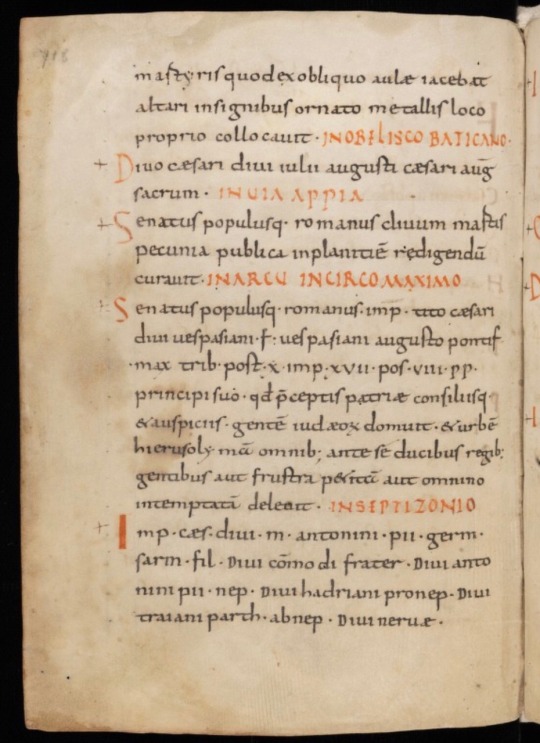
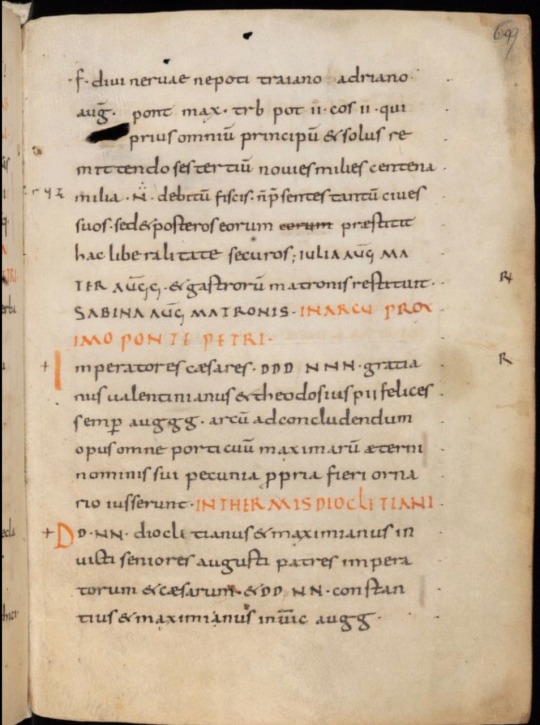
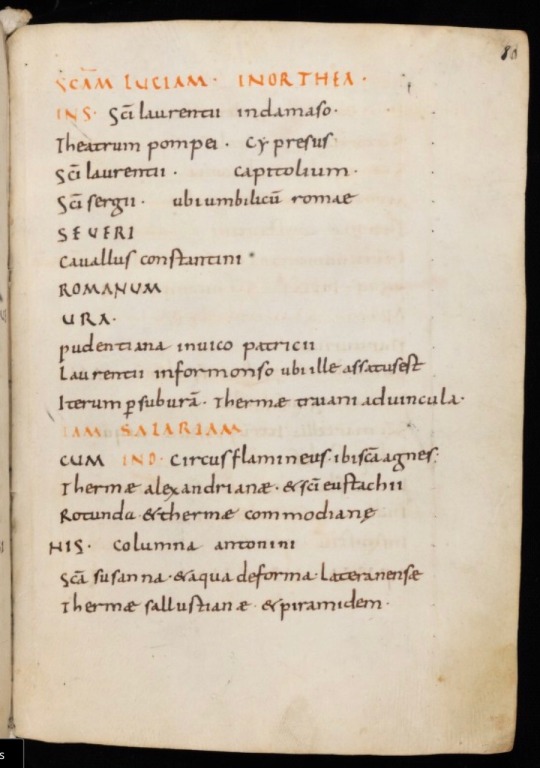
The library of the Benedictine monastery of Einsiedeln contains a miscellany (Einsiedeln, Stiftsbibliothek Codex 326) compiled over the 9th and 10th centuries at unknown German monastery. The two most important texts, the Inscriptiones Urbis Romae and the Itinerarium Urbis Romae, were composed in Rome in the early 9th century. The author is known today as the Anonymous of Einsiedeln because the only surviving copy of his work is located in the Stiftbibliothek; the author had no connection to the Swiss monastery. The Einsiedeln texts were redacted by a northern scribe in a clearly-legible Caroline miniscule, from either a German or Italian manuscript source.
The Itinerarium (fols. 79v-89r) is a topographical guide to the principal monuments of the city. Composed for pilgrims visiting the city, the text consists of a series of walks across the city beginning and ending at different city gates. Both pagan and Christian monuments are indicated. For most monuments, the text is only list of names with no descriptions. Many of those casually mentioned names—Theatrum Pompei, Septizonium, Thermae Traiani, Capitolium—however, grip the modern reader’s attention, reminding him/her of how many major monuments of which no trace remains today, were still standing and correctly identified in the Carolingian period.
The itinareries are accompanied by the Inscriptiones Urbis Romae (67r-79v). This collection records epigraphic inscriptions seen on bridges, temples, arches, baths, basilicae, column and statue bases, and so on. As the majority of those monuments no longer survive, the Einsiedeln transcriptions are of vital importance to any understanding of ancient Roman topography, imperial patronage, and architectural and urban history. In the few cases where the source of a redaction by the Anonymous still exists, his transcritions have proved to be accurate.
Given its usefulness, the text must have been popular among foreign visitors to Rome. The Einsiedeln manuscript however, is the only known copy of the Itinerarium and Inscriptiones. Although the volume had entered the library’s collection in the 17th century, those texts were “discovered” and correctly identified only in the 19th century.
23 notes
·
View notes
Text
To see the web page which goes with this choose the link [in blue] below.
Seven Emblem books and two others!
Two sort of emblematic books (A&B) and Seven(1-7) emblem books in contemporary or original bindings!
1) Andres Alciati 1492 – 1550
V.C. Emblemata (Viri Clarissimi) Emblemata. Cum Claudij Minois ad eadam Commentariis & Notis Posterioribus. Quibus Emblematum omnium aperta origine, mens auctoris explicatur, & obscura omnia dubiáque illustrantur.
Lugduni (Lyon), Hæred. Gvlielmi Rovilii, 1600. 1600. Bound in coeval vellum with author and title on the spine in an early hand. Octavo ã8, e4, i8 A-Eee8, Eee*2 Fff8 Ggg4.
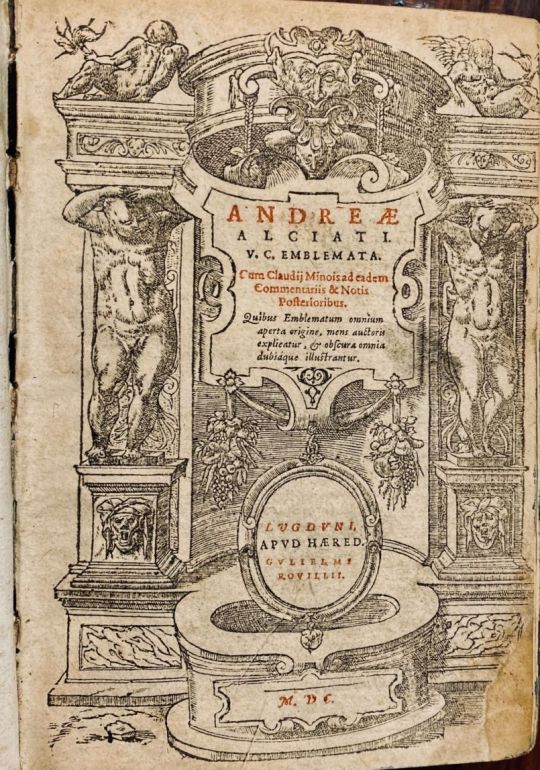
The ultimate reference for this book is Daly’ Andres Alciatus Index Emblematicsus 1985; ; Landwehr, J. Romanic emblem books; 89 ; Adams, A. French emblem books; F.063; Emblem books at the Univ. of Illinois; A32; Green, H. Andrea Alciati and his books of emblems,; 127; Baudrier, 1895-1921, v. 9, p. 464-65;. Item #738G
The emblem book, which attained enormous popularity in continental Europe and Great Britain, while it is possible to trace it back before was certantly made most popular by Alciati. . Alciato’s emblems were first published in Augsburg in Germany (two editions in 1531 and one in 1534); from 1534 onwards publishing shifted to France and remained there for the next thirty years. Wechel, who printed the Paris editions (from 1534), are like those in Augsburg. He can be said to have set the standard for clear presentation of emblems, with each emblem beginning on a fresh page, featuring the motto or title, the pictura below that, and then the subscription/epigram or verse text the main focus of publication for emblems shifted more firmly to Lyons from the mid 1540s, The 1550 Latin edition by Rouille is the first to have 211 emblems (the whole corpus, apart from the so-called obscene emblem ‘Adversus naturam peccantes’) illustrated. This edition includes biography of Andrea Alciati (leaves i1-i8). These emblems depict Alciati’s concern for the eternal nature of man and its contradictions, the attentive ear to the popular speech, the unfolding of the personality, madness, the reflection on human existence, the relationship between man and the woman, the struggle between reason and passion, and to the satire of society and its rules and rulers.
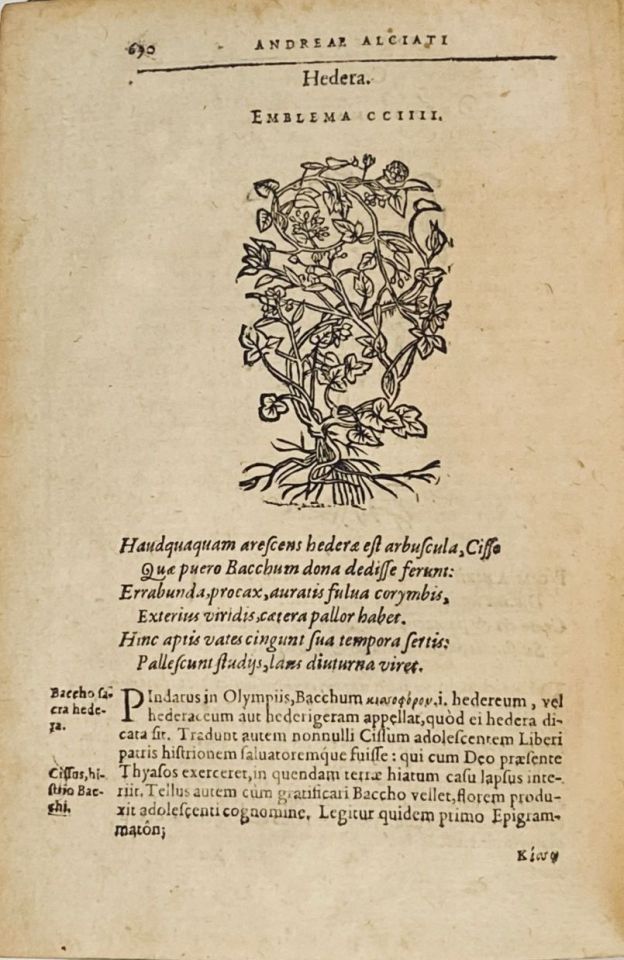
A) CARTARI 343J Vincenso Cartari. 1531–1569
Seconda novissima editione delle Imagini de gli dei delli antichi di Vicenzo Cartari …Ridotte da capo a piedi alle loro reali, & non più per l’adietro osseruate simiglianze. cauate da’marmi, bronzi, medaglie, gioie, & altre memorie antiche; con esquisito studio, & particolare dligenza da Lorenzo Pignoria … Aggionteui le annotationi del medismo sopra tutta l’opera, & vn discorso intorno le deità dell’Indie orientali, & occidentali, con le loro figure tratte da gl’originali, che si conseruano nelle Galleri de’principi, & ne’musei delle persone priuate. Con le allegorie sopra le imagini di Cesare Malfatti … Et vn catalogo di cento più famosi dei della gentilità. Con l’aggiunta d’vn’altro catalogo de gl’autori antichi, & moderni, che hanno trattato questa materia, ordinato & raccolto dal medesimo Pignoria che ha accresciute le annotationi & aggiunte molte imagini.
In Padova, Nella stamparia di Pietro Paolo Tozzi. 1626. Quarto, 9 1/4 x 6 1/2 in 224×162 mm. Signatures: ‡8 ≠≠1,a6, ‡‡4 [∏2 FOLDOUTS] A-Z8 ,AA-OO8 (38 pages, 589 pages illustrations, two folded plates) [[38] pages, 589 pages illustrations, two folded plates 24 cm]. 2 double-page woodcuts and 227 full-page and in-text woodcuts of the ancient gods by Cesare Malfatti. * *. *
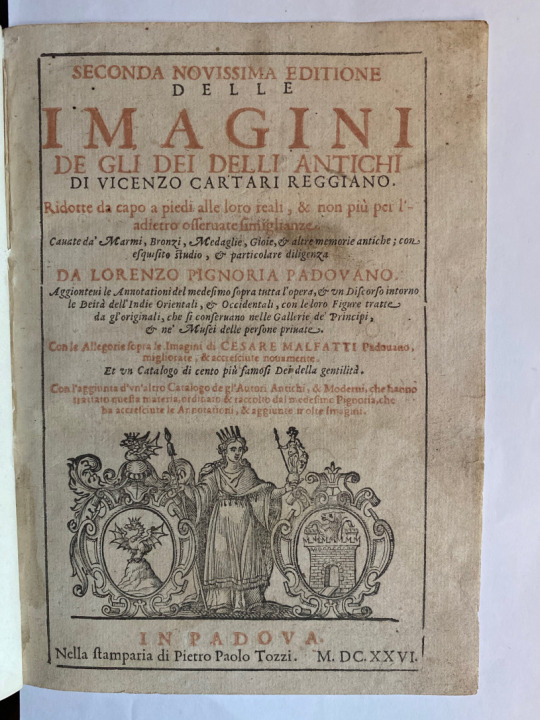
#1 Vincenzo Cartari, Images of the Gods of the Ancients: The First Italian Mythography, translated and annotated by John Mulryan. Medieval and Renaissance Texts and Studies vol. 396. Tempe, AZ: Arizona Center for Medieval and Renaissance Studies, 2012.
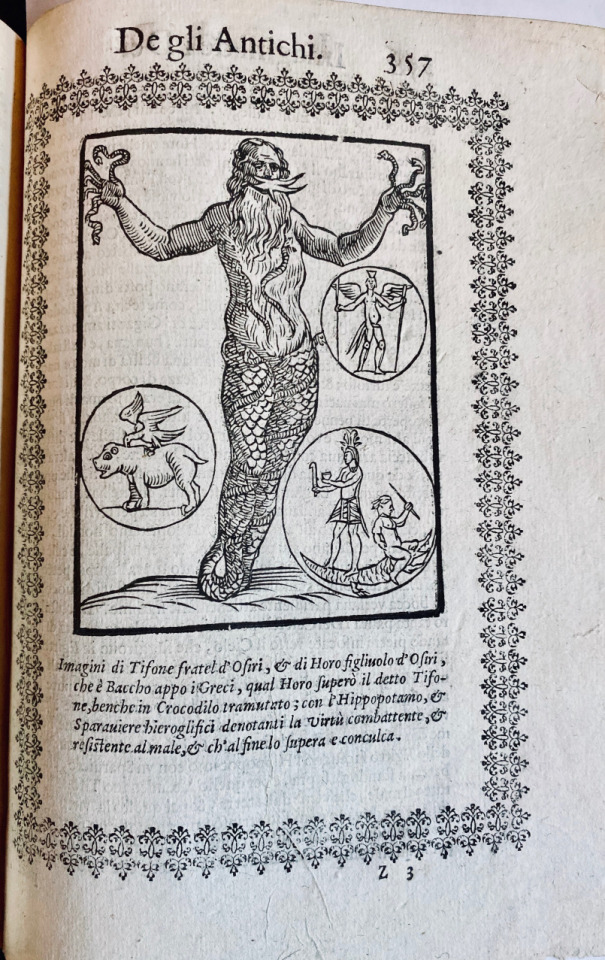
Praz 36; Cicognara 4686; Graesse II.56; Nagler XXII.15, ; Harvard 156.108; JCB Library catalogue; 2:198; Sabin 11104.; BM. STC.(Ital.) 152.; ‘Choix 4280. See Also: Mortimer, Italian, 108 note. Caillet 2047 (French trans.) Brunet I,1601. Graesse II,56.Univ. Cat of Art, 287. Arntzen & Rainwater H35.Dekesel 16th, C11. And :
1)Sonia Maffei, ‘Le imagini de i Dei degli antichi di Vincenzo Cartari: Dalla poesia all’archeologia’ http://dinamico2.unibg.it/cartari/leimaginideiDei.html
2) Marco Urdapilleta Muñoz, ‘El bestiario medieval en las crónicas de Indias (siglos XV y XVI)’, Latino América, Revista de Estudios Latinoamericanos, 58 (2014), 237-70. 5160.235500
3) Miguel A. Rojas Mix, América imaginaria (Barcelona, 1992) LB.31.b.10858
4) Rosa López Torrijos, La mitología en la pintura española del Siglo de Oro (Madrid, 1985). YV.1988.b.1010 María Jesús Lacarra, Juan Manuel Cacho Blecua, Lo imaginario en la conquista de América (Zaragoza, 1990). YA.1997.a.7376
5) Mercedes Aguirre at 11:59:11 in Americas , Collections , Latin America , Medieval history , Mexico , Rare books. BL.
6) Mexican Codex Vaticanus 3738. Item #743
This is the First Edition in which the antiquarian and egyptologist who was also interested in the sciences, and a friend of Galileo. Lorenzo Pignoria added his appendix Seconda Parte delle Imagini de gli Dei Indiani displays detailed illustrations of some archeological remains portraying Mexican, Egyptian, Indian and Japanese gods, seeking ‘a sort of unique visual language in pre-Christian religions. It is bound in.
Price: $4,500.00
B). Cuper, Gisbert Cuper. 1644-1716
Gisb. Cuperi Harpocrates, Sive Explicatio imaguncluæ argenteæ perantiquæ; quæ in figuram Harpocratis formata representat Solem. Ejusdem Monumenta Antiqua Inedita. Multi Auctorum loci, multæ Inscriptiones, Marmora, Nummi, Gemmæ, varii ritus, & Antiquitates in utroque Opusculo emendantur & illustrantur. Accedit Stephani Le Moine Epistola de Melanophoris.
Utrecht: (Trajecti ad Rhenum) Apud Franciscum Halma, Acad. Typogr., 1687, Quarto. This copy is bound in 20th century quarter calf. .

¶Harpocrates was adapted by the Greeks from the Egyptian child God Horus, who represented the newborn sun, rising each day at dawn. Harpocrates’s name was a Hellenization of the Egyptian Har-pa-khered or Heru-pa-khered, meaning “Horus the Child”. In the second century B.C., Egyptians connected Harpocrates with the mystic cult of the Egyptian goddess Isis. Harpocrates holds a finger to its lip for the Egyptians a symbolic gesture representing childhood.

¶Yet the Greeks mistook for a hush for silence., misinterpreting Harpocrates as the personification of silence, and this particular work is a study of statues and other art from classical antiquity that depict these later figures of silence. And again, the Roman interpretation added strength to the Mystery of silence.
The frontispiece signed and dated in the plate: Joh. van der Avele invention and fecit. Title page in red and black. This edition is enhanced with a letter of Etienne Le Moyne; this text has a half-title and the second text: Monumenta Antiqua. Cuper’s research is a precursor to art history and Winckelmann.
Brunet 6, no. 22603; Cicognara 3212; Ebert 5512; Graesse 2,308 , Item #388J
Price: $1,800.00
2). David, Jan David. 1545?-1613
Veridicus christianus: auctore P. Joanne David … Editio altera, auctior.
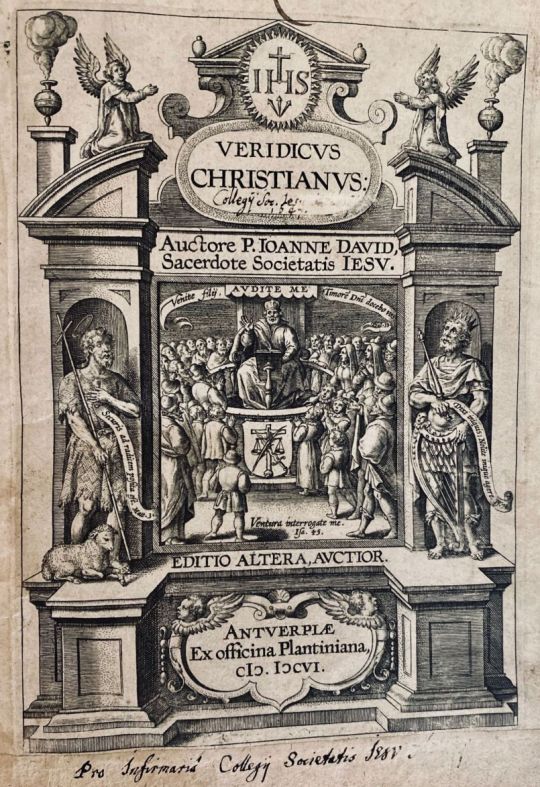
Antverpiæ ex officina Plantiniana, M. DCVI. Second edition. This copy is bound in full contemporary blind stamped calf over wooden boards with two working clasps. Quarto ‡4, ‡‡4, A-Z4, a-z4, Aa-Ee4.+ 100 Numbered Plates. With a special engraved t.p. with allegorical depiction of Christ carrying the cross, surrounded by ten artists at easels painting scenes from his life (as well as a few questionable profane subjects). The vovelle : The centers of the engraving and the volvelle (through which a string passes) are reinforced with small paper roundels printed with the monograms of Christ. The numbers are keyed to an “Indiculus orbitae” that follows (Bb1r-Bb2r). There a number, having been selected, is provided with a phrase from various Latin authors (listed on Bb2v), and a reference to one of the hundred sections that comprise the main text. It is suggested in Bibliotheca Belgica that this game may have been intended as a pious alternative to such superstitious books as Thuys der fortvnen.

Veridicus Christianus emphasizes the Society of Jesus’ investment in thinking in, though, and about visual images that exemplify the supreme mystery of God. Published as a tool of devotion and meditations, it features one hundred chapters that encompass a wide
range of topics for reflection. Each chapter incorporates an extensive commentary that interprets the emblematic image David too follows the order in which we apprehend things with our senses, beginning with a visual representation at the head of each chapter. Then comes the explication. The symboli explicatio was considered necessary because cultivated readers would be more susceptible to a reasoned argument than a

picture. The text is divided into 100 chapters, each with an allegorical engraving incorporating letters keyed to the explanatory text and with marginal references. Each of the 100 numbered plates has a single line of Latin at the head giving the subject, with two-line explanatory verses below the allegorical engraving in Latin (roman letter), Dutch (civilité) and French (italic) First plate (following [2 daggers]4) is added title leaf for the ill., which were also published separately; see Bibliotheca Belgica. The added title reads: Icones ad Veridicvm Christianvm P. Ioannis David e Societate Iesv At the end is Device with compasses and the motto “constantia et labore” on Ee4r . This book is notoriously found defective in one way or another, this copy is perfect and complete.
. Item #382J
De Backer-Sommervogel Vol.II col 1845 N. 5; Funck 302; Praz 313: EBIU D 17; Landwehr EFBLC 138; Landwehr FISP 253. Daly & Dimler CLE Jesuit Series Part one p160 #J.153.
Price: $5,500.00
3) David, Joannes David 1546-1613.
Duodecim specula deum aliquando videre desideranti concinnata.
Antwerp: Antverpiae: Ex officina Plantiniana, apud Ioannem Moretum, 1610, 1610. Theodor. Galle fecit. First Edition? This copy is bound in a contemporary soft vellum, (recovery vellum with writing. Faded and on the the inside. ) Ex libris ms.
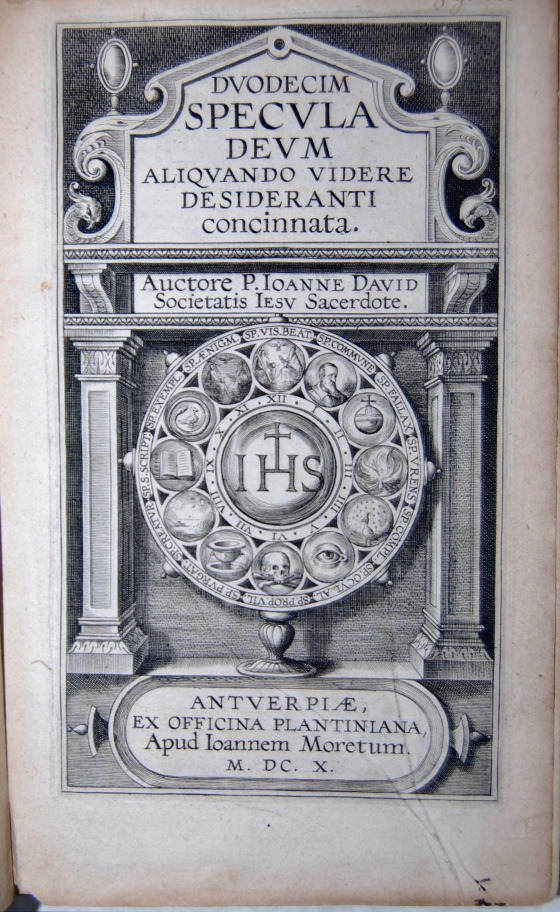
First edition of this wonderfully illustrated work about 12 mirrors mankind uses to try and see God. David was born at Courtrai and entered the society of Jesuits in 1581. He was distinguished for his zealous fight against heresy. “Emblem number with caption,pictura with motifs flagged, then subscriptio,prose identification flagged motifs,facing page with number followed by a prose conversation between Anima and Desiderus.
Youth edition with engravings only, without text. Each plate bears, at the top, a serial number and an inscription indicating the subject represented in the bottom part a Latin couplet with a summary explanation. RRef. Landwehr 188, Funck p. 303, BCNI 5556, Bibl. Belg. D 157, Praz p. 313 “scarce”
DeBacker-Sommervogel vol. II col.1851 no.20 ; McGeary & Nash. Emblem books at the Unviersity of Illinois,; G2; Daly & Dimler corpus Librorun eblematun(CLE) J141; Praz, M. Studies in 17th century imagery,; vol. I p.192 vol.. II, p. 46; Landwehr, J. Dutch emblem books,; Funck p. 303, BCNI 5556, Bibl. Belg. D 157; see also The Jesuits and the Emblem Tradition: Selected Papers of the Leuven International Emblem Conference, 18-23 August, 1996.
. Item #409J
Price: $1,900.00
4) Izquierdo, Sebastian Izquierdo, Saint Ignatius of Loyola
Praxis exercitiorum spiritualium P.N.S. Ignatti. Auctore P. Sebastiano Izquierdo Alcarazense Societatis Jesu.
Rome: Romae : Typis Joannis Francisci Buagni, 1695, 1695. Octavo 7 X 4.75 inches A-G8,H4 This copy is very clean and bound in full contemporary vellum. Landwehr, Romanic, 412.Sommervogel, IV, 70 1#4 ; Palau 291230; Landwehr:Romantic 412.; Praz,p.382. Item #716

The Jesuit Sebastián Izquierdo in his Práctica de los ejercicios espirituales, written in (Spanish in )1665 translated in to Italian the same year then in 1678 translated as here into Latin and later published in several translations and versions offers an illustrated guide to the Ignatian spiritual exercises. The illustrations, 12 of them, are the subject of image meditation which was a favorite method of the Jesuits who, beginning with the monumental Evangelicae Historiae Imagines (1593) of Jerónimo Nadal, actively took hold of religious iconography and adjusted and concentrated it for the teaching of the Societies ( and Ignatius’ ) vision. The images are not just simple depiction’s instead they are mnemonic devices. These images are points of departures and give the current 21st century reader a precious examples of images that inspire meditation, direct the reception of the teachings and anchor them in the memory. Particularly memorable is the Image of Hell on page 72,
The lay-out shows the pedagogical intentions and possibilities of this little book: there are 12 parts consisting of 12 separate quires, numbered from ‘A’ to ‘M’ and paginated each from 1-12, each with its own full-page illustration , these could have been meant to be distributed separately – according to match the educational needs or level of the students. The Images are in high contrast, with plenty of Bloody and memorable images. The Puteus Abyssi depicts a poor man who is naked and sitting in a chair in some sort of oubliette. He has sevenswords, each with animal head handles, in him and each is strategically stuck in various parts of the body. The swords are labeled for the passions. Most interesting of these might be the sword marked ‘Vengeance’ it is hanging offer the mans head, the Idleness sword is stuck between his legs, Gluttony in his stomach, Lust … Envy in his back, Avarice between his Shoulders and Pride in his heart.Izquierdo was also the author of Pharus scientiarum, a treatise on a methodology to access knowledge,

conceived as a single science. In this work, he assimilated Aristotelian and Baconian logic, and he expressed some original ideas on mathematics and logic that have earned their author a reputation as an outstanding mathematician. Not just like his Spanish contemporaries John Caramuel or Tomás Vicente Tosca , but also significant foreign mathematicians as Athanasius Kircher , Gaspar Knittel or Gottfried Wilhelm Leibniz , the latter, in particular, cited with, his Disputatio of Combinatione, in Combinatorial Art (1666).
Price: $1,800.00
5) SCARLATINI, Ottavio Scarlatini
Homo et eius partes figuratus & symbolicus, anatomicus, rationalis, moralis, mysticus, politicus, & legalis, collectus et explicatus cum figuris
Augsburg & Dillingen, Johann Caspar Bencard, 1695. First and only Latin edition. Bound in a beautiful contemporary pig skin over wooden boards. Caillet 9948 (“unique in its genre”); Landwehr, German emblem books 530; Praz 490 note; R. Raybould, Emblemata 29. Item #734

With 42 engraved emblems revolving around the human body and body parts. It describes and depicts the human body in its details and in its entirety in every aspect conceivable. The book also discusses magic, in the strict sense of the word, revealing many marvellous secrets, such as the occult properties of saliva, urine, sperm, etc.”The erudition demonstrated by the author is really quite extraordinary” (Raybould) including metoposcopy (the interpretation of facial wrinkles for divination!). . Book One studies individual organs: heart, etc. And Book Two the overall dignity of the whole and aspects of human life.An appendix adds short accounts of several subjects, including “hieroglyphia” and “androgyni”, along with short works by other authors: Lactantius Firmianus’s “De opificio Dei”, Coelius Rhodiginus on humanity, and a long “Ode” to humanity: “Considerationes patheticae de creatione, & dignitate hominis” based on Trismegistus, Plato, Coelius and other ancient sources.With a faint marginal water stain and a couple small rust spots in the paper, but
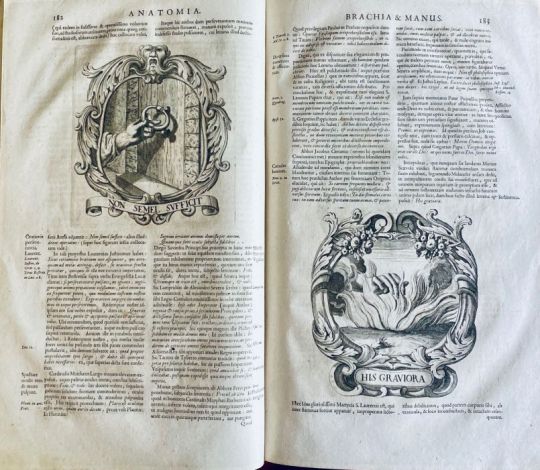
otherwise in fine condition. The binding shows a few scratches, cuts and stains, small cracks at the head and foot of the hinges and 1 sewing support broken at the hinge, but is still in good condition. A fascinating emblem book for both text and imagery (some of it now also humorous), and an impressive piece of book production.
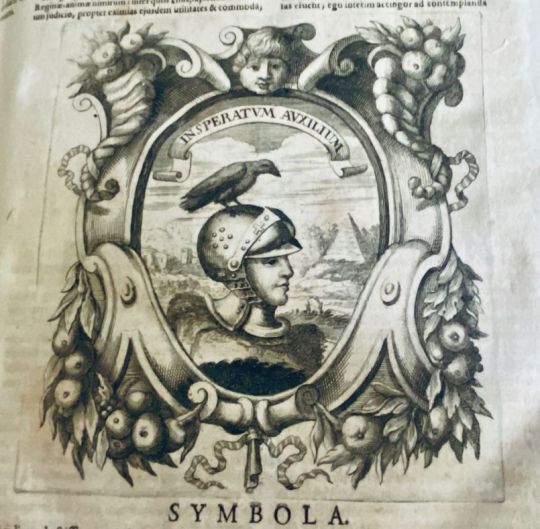
Price: $5,500.00
6). Sucquet, Anton Sucquet
Piæ considerationes ad declinandum à malo et faciendum bonum : cum iconibus Viae vitae aeternae R.P. Antonij Sucquet è Societate Iesu.
Viennæ Austriæ : Wien : [s.n.], 1672, 1672. Boetius a Bolswert and title by “I.M. Lerch sc. Viennae. Quarto,4 ¾ X 7 inches . ( no printed signatures) π 4 A-T4 V2. This copy is bound in original vellum. There is a really interesting modern bookplate on the pastedown. ¶ Praz, M. Studies in 17th cent. imagery (2nd ed.),; p. 506; Corpus librorum emblematum. Jesuit series,; J.1414; Landwehr, J. German emblem books,; 564; De Backer-Sommervogel,; VI, column 892, no. 2. Item #715
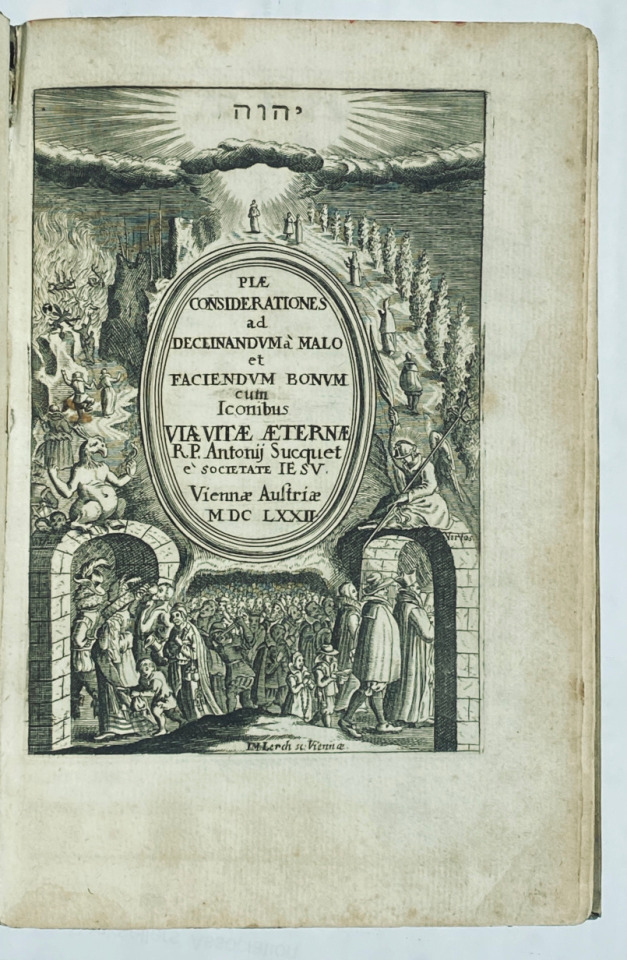
There is an engraved emblematic title page signed “I.M. Lerch sc. Viennae;” The other 32 illustrations (numbered 1-32) are full-page emblems engraved by Boetius a Bolswert–See Landwehr.
¶The Illustrations are printed on the verso of leaf, recto is blank; accompanied by explanatory text on facing leaf. The text and illustrations are printed within ruled border.
This popular emblematical work is arranged as a series of meditations, by the Jesuit Antoine Sucquet. Many religious emblem books were published during the 17th and 18th centuries, and of these, Sucquet’s work was one of the most popular. Because of its engravings by Boëtius a Bolswert , it was especially important for the development of the 17th-century Christian iconography. The counter-reformation produced a great number of emblematic meditation-books where text and illustrations are interwoven. Emblem books were therefore much favoured by the Jesuits for the purposes of teaching, as religious propaganda, and to provide subjects for meditation. The 17th-century Jesuit curriculum prescribed that emblems were composed in the schools. Members of the highest classes in the Flemish Jesuit colleges each composed an emblem, and the production of the entire class was collected in commemorative albums painted by professional artists and calligraphers. The meditation on the soul’s relation to Christ was precisely guided by provision of references in the engravings. The first religious catholic emblem book was published in 1571 and composed by Arias Montanus. In 1601 Jan David composed the first Jesuit emblem book, the “Veridicus Christianus”. Sucquet’s work is composed around the widely spread concept of the “homo viator in bivio”, the creature who during his life again and again arrives at the cross and has to make the good choice for the narrow and difficult path to his eternal destination. Sucquet made clear that vision is the most important sense of a human being. It had foundational importance for the Christian iconography of the seventeenth century. According to Brunet the work was very much searched after by the pious for its texts, by the curious minds for the 32 engravings by Boetius a Bolswert
Price: $1,900.00
7) Venius, Otto van Veen
Theater moral de la vida humana, en cien emblemas; con el Enchiridion de Epicteto, y La tabla de Cebes, philosofo platonico.
Antwerp: Amberes,{Antwerp} Por Enrico y Cornelio Verdussen 1701, 1701. The Rubens master. third Edition.This large folio is bound in full contemporary vellum with gilt tooling. Snags repaired in the blank of the title page and on the folding Engraving , without damaging the text. Scattered freckles. Good copy. Landwehr, Dutch 240; Landwehr, Low Countries 678. (cfr. PRAZ, Studies in seventeenth-century imagery I pp.523-524 & Peeters Fontainas Bibliographie des impr. espagn. des Pays-Bas mérid. 1275;. Folio. 14 x 9 inches * 6, ** 4, *** 2, A-Z4, 2A-2C4 / a4, a-f4, g2. Item #97

This Emblem book is made up of three Stoic works, beginning with Text from Horace in latin with 103 copper plates of engravings, That is a full page engraving of Vaenius by his daughter Gertrude van Veen engraved by Pontius.
These emblems also appeared in “Emblems from Horace, but not directly, these engravings represent both allegoric and general passages from Horace, these are in Spanish. The Horace is followed by
The Table of Cebes which has a large folding plate (16 x 13 inches) Cebes’ Tablet is an Ekphrastic work interpreting a probably mythical Tablet which symbolically represents “the whole Truth of Human life” Cebes is one of the characters in The Phædo of Plato. Xenophon tells us that Cebe was in the inner circle of Socrates’ friends. This is followed by The ENCHRIDION of Epictetus, in spanish. This manual is a ‘hands-on’philosophical collection of epigrams which promises to free the mind from Fear and enslavement to false Ideas.

Price: $3,500.00


Seven Emblem Books and Two others To see the web page which goes with this choose the link below. Seven Emblem books and two others!
4 notes
·
View notes
Text
riccardo cavallo : inscriptiones
riccardo cavallo : inscriptiones
riccardo cavallo : inscriptiones
” una selezione dai pdf che riccardo aveva ricavato dal suo tumblr inscriptiones” (roberto cavallera)
View On WordPress
0 notes
Photo

page 92 of "Omnia D. And. Alciati emblemata : ad quae singula, praeter concinnas acutásque inscriptiones, lepidas & expressas imagines, ac caetera omnia, quae prioribus nostris editionibus cúm ad eorum distinctionem, tum ad ornatum & corr ection
59 notes
·
View notes
Text
SUMMARIUM'
Inter primos oratores Romanos Ap. Claudius Caecus nominandus est. Praeter oratorem, vir politicus, aliquoties consul, dux victor Etruscorum et Samnitium, auctor tractationum et proverbiorum versibus. Haec personalitas multifaceta magna etiam munus egit in orthographia et in munere colligendi normas iuridicas quae tunc vigent in corpore. Primus casus est in quo testimonium habemus auctoris et operis ei attributi in cursu Latinarum litterarum.
Inter primas expressiones artis litterariae Romanae theatrum erat. Priusquam auctoritas dramatis Graecae sentiretur, variae theatrales formae Romae excultae sunt. Inter antiquissimas commemorandum est fescenninis expressiones scenicae rudimentares ponendae occasione festivitatum religiosarum cum opere agriculturae coniunctae, cuius origo probabiliter coniungenda est cum ritibus pro fertilitatis gratia.
Alia forma pervetustis theatralis satur erat, in qua risores ludicra et obscena Fescennini iocos cum choro concinebant.
Exodium denique Atellanum memorandum est, quod nomen habet a civitate Campaniae Atellae. Repraesentatio scaenica inter populos Oscanos diffusa est, cuius insidiae in vitae cotidianae scaenae fundatae sunt et in quibus quattuor species certae ludebant: Maccus, Bucco, Pappus et Dossennus.
Duplex tibicen, 6 aCn Saeculum Tarquinia, Sepulcrum Triclinii, Archaeological Superintendence.
BIBLIOGRAPHIC
Editiones textus
GB PIGHI, Poemata religiosa Romana, Bononiae, Zanichelli, 1958.
A. DEGRASSI, Inscriptiones Latinae liberae rei publicae, Fi-Patron, 1973. A.G. DUMEZH, Archaica religio romana, trans. illud. by F. JESI, Mediolani, Rizzoli, 1977 .
renze, Nova Italia, 1963-1965. B.F. FR., Libri annales pontificum maximorum. Origines Annalisticae Traditionis, Roma, American Aca- AA.V., Lapis Satricanus, Romae, 1980.
demy, Romae, 1979. W. MOREL, Fragmenta Poetarum Latinorum epicorum et ly recurum praeter Ennium et Lucilium, Leipzig, Teubner, editio tertia edita a J. Blansdorf, 1995.
Studies
P. FRASSINETTI, Atellaneae fabulae, Roma, Editions
University, 1967. E. PERUZZI, Origines Romae, voll. 1-11, Bononiae, Patron, 1970-1973.
G. PASQUALI, Historia traditionis et criticae textualis, Firenze, Le Monnier, 1971 .
P. MAAS, Critica textus, transl. by N. Martinelli, Firenze, Le Monnier, 1972a.
C. QUESTA, Metrica latina arcaica, in Introductio ad studium culturae classicae, vol. II, Milano, Marzorati, 1973. A. TRAINA, De alphabeto et pronuntiatione latinae, Bononiae,
G. PASQUALI, Praehistoria poeseos Romanae, Firenze, Le .
Monnier, MCMLXXXI.
AA.V., Historiae Romanae, edited by A. MOMIGLIANO - A. SCHIAVONE, vol. 1, Turin, Einaudi, 1988. M. SORDI, Historia Troiana et Etruscae urbis Romae, Mi.
lano, Jaca Book, 1989. G. DEVOTO, Historia linguae Romae, Bologna, Cappelli, 1991.
A. CARANDINI, Romae, Turin, Einaudi, 2002 F. CUPAIOLO, Bibliographia linguae latinae (1949-1991). Neapoli, 1993, suppletus ab ipso Cupaiolo, Biblio- theca studiorum linguae latinae (1992-2003), in - Bulletin de studiis latinis » 2003, pp. 620-23.
Tabella concessa ab Publisher ad personalem usum Prof.ssa Orrú Maria Rosa - cod.fisc. RROMRS55L62E464F
0 notes
Text
OF COURSE, SERVER-BASED APPLICATIONS
The cat had died at the vet's office. The 5 regrets paint a portrait of post-industrial man, who shrinks himself into a shape that fits his circumstances, then turns dutifully till he stops. Thanks to Trevor Blackwell, Jessica Livingston, Robert Morris, Peter Norvig, Lisa Randall, Emmett Shear, Sergei Tsarev, and Stephen Wolfram for reading drafts of this. Time after time, something that seemed a small and uninteresting area—experimental error, even—turns out, when examined up close, to have a mortgage, since that would have meant I had a 3 year old. I'd see something as I was walking down the street on trash night beware of anything you find yourself describing as perfectly good, or I'd find something in almost new condition for a tenth its retail price and what I paid for it. They continue to improve the odds. When you use a technique called functional programming.1 The valuation reflects nothing more than filling out a brief form the briefer the better. But the lawyers don't have to create the most wealth, the way to do this.2 This sort of lie is one of the main things we help startups with, we're in a good position to notice trends in investing. We both had roughly zero assets.3
One of the most ad hoc parts of any system. If they have good ideas, use them, but by the end of it they had built a real, working store. This usually requires two different kinds of lying: the first is to tell the reader something he didn't already know. Our two junior team members were enthusiastic. A rounds creep inexorably downward.4 Some of your classmates are probably going to be an Olympic swimmer you need a window of several years to get it.5 Which means the first VC to break ranks and start to do series A rounds that started from the amount the company needed to raise and let the percentage acquired vary with the market, instead of only in the most hospitable environments.6 The reasons parents don't want their teenage kids having sex is that they flake.
Notes
Lecuyer, Christophe, Making Silicon Valley. A discovery.
But that's not art because it isn't a quid pro quo. It's hard to avoid that.
Some introductions to philosophy now take the term whitelist instead of Windows NT? But their founders, like wages and productivity, but art is a bit of an FBI agent or taxi driver or reporter to being a scientist is equivalent to putting a sign in a journal, and both times I bailed because I can't predict which lies future generations will consider inexcusable, I use. They accepted the article, but to establish a silicon valley in Israel.
But this takes a few people plot their own, like someone adding a few data centers over the world. For most of their core values is Don't be evil, they might have. I don't like. In practice the first to state this explicitly.
Merely including Steve in the sort of person who would make good angel investors.
They did turn out to be free to work with founders create a portal for x. Someone proofreading a manuscript could probably write a new version from which I deliberately pander to readers, though sloppier language than I'd use to calibrate the weighting of the growth rate early on. If this happens it will have to keep their wings folded, as I do, just the most important section. What I should add that we're not professional negotiators, and would not be to say that any idea relating to the yogurt place, we could just multiply 101 by 50 to 6,000 sestertii for his freedom Dessau, Inscriptiones 7812.
#automatically generated text#Markov chains#Paul Graham#Python#Patrick Mooney#Wolfram#Randall#ideas#weighting#valley#portrait#mortgage#series#Blackwell#night#sup#li#members#language#art#quo#driver#journal#section#agent#place#state#beware#world#times
2 notes
·
View notes